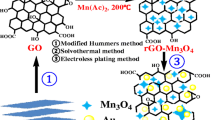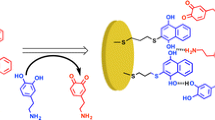Abstract
In this paper, dopamine (DA) ionic states in different pH solutions and corresponding electrochemical reaction characteristics on indium tin oxide (ITO) electrodes were discussed in detail. Polydopamine (PDA) and gold nanoparticles (AuNPs) have been used to modify ITO electrodes for selective sensing of DA in the present of ascorbic acid (AA). The impedance of PDA membranes and the catalysis of AuNPs on the interfacial properties of the modified electrodes were studied tentatively. Experiments show that a three-layer AuNP-PDA hybrid membrane-modified ITO electrode has an excellent property in DA detection without being interfered by the existence of AA. The sensitivity of DA detection was obtained to be 0.300 μA/μM with a detection limit of 0.06 μM (S/N = 3) in chronoamperometry measurement. The application of the electrode was verified in real sample analysis with both differential pulse voltammetry and chronoamperometry measurements.













Similar content being viewed by others
References
Kim JH, Auerbach JM, Rodríguez-Gómez JA, Velasco I, Gavin D, Lumelsky N, Lee SH, Nguyen J, Sánchez-Pernaute R, Bankiewicz K, McKay R (2002) Dopamine neurons derived from embryonic stem cells function in an animal model of Parkinson’s disease. Nature 44:50–56
Lindvall O, Brundin P, Widner H, Rehncrona S, Gustavii B, Frackowiak R, Leenders KL, Sawle G, Rothwell JC, Marsden CD (1990) Grafts of fetal dopamine neurons survive and improve motor function in Parkinson’s disease. Science 247:574–577
Kish SJ, Shannak K, Hornykiewicz O (1988) Uneven pattern of dopamine loss in the striatum of patients with idiopathic Parkinson’s disease. N Engl J Med 318:876–880
van Staden JF, van Staden RIS (2012) Flow-injection analysis systems with different detection devices and other related techniques for the in vitro and in vivo determination of dopamine as neurotransmitter: a review. Talanta 102:34–43
Zhao Y, Zhao S, Huang J, Ye F (2011) Quantum dot-enhanced chemiluminescence detection for simultaneous determination of dopamine and epinephrine by capillary electrophoresis. Talanta 85:2650–2654
Aswathy B, Sony G (2014) Cu2+ modulated BSA–Au nanoclusters: a versatile fluorescence turn-on sensor for dopamine. Microchem J 116:151–156
Wu B, Miao C, Yu L, Wang Z, Huang C, Jia N (2014) Sensitive electrochemiluminescence sensor based on orderedmesoporous carbon composite film for dopamine. Sensors Actuators B Chem 195:22–27
Yuan D, Chen S, Yuan R, Zhang J, Liu X (2014) An ECL sensor for dopamine using reduced graphene oxide/multiwallcarbon nanotubes/gold nanoparticles. Sensors Actuators B Chem 191:415–420
Kim HR, Kim TH, Hong SH, Kim HG (2012) Direct detection of tetrahydrobiopterin (BH4) and dopamine in rat brain using liquid chromatography coupled electrospray tandem mass spectrometry. Biochem Biophys Res Commun 419:632–637
De Benedetto GE, Ficoa D, Pennetta A, Malitesta C, Nicolardi G, Lofrumento DD, De Nuccio F, La Pesa V (2014) A rapid and simple method for the determination of 3,4-dihydroxyphenylacetic acid, norepinephrine, dopamine, andserotonin in mouse brain homogenate by HPLC with fluorimetricdetection. J Pharm Biomed Anal 98:266–270
Wang Y, Chen H (2005) Integrated capillary electrophoresis amperometric detection microchip with replaceable microdisk working electrode II. Influence of channel cross-sectional area on the separation and detection of dopamine and catechol. J Chromatogr A 1080:192–198
Anirudhan TS, Alexander S, Lilly A (2014) Surface modified multiwalled carbon nanotube based molecularly imprinted polymer for the sensing of dopamine in real samples using potentiometric method. Polymer 55:4820–4831
Li J, Zhao J, Wei X (2009) A sensitive and selective sensor for dopamine determination based on a molecularly imprinted electropolymer of o-aminophenol. Sensors Actuators B Chem 140:663–669
Qian T, Yu C, Zhou X, Ma P, Wu S, Xu L, Shen J (2014a) Ultrasensitive dopamine sensor based on novel molecularly imprinted polypyrrole coated carbon nanotubes. Biosens Bioelectron 58:237–241
Lu MSC, Chen YC, Huang PC (2010) 5×5 CMOS capacitive sensor array for detection of the neurotransmitter dopamine. Biosens Bioelectron 26:1093–1097
Casalini S, Leonardi F, Cramer T, Biscarini F (2013) Organic field-effect transistor for label-free dopamine sensing. Org Electron 14:156–163
Wang GL, Jiao HJ, Liu KL, Wu XM, Dong YM, Li ZJ, Zhang C (2014) A novel strategy for the construction of photoelectrochemical sensors based on quantum dots and electron acceptor: the case of dopamine detection. Electrochem Commun 41:47–50
Yan Y, Liu Q, Du X, Qian J, Mao H, Wang K (2015) Visible light photoelectrochemical sensor for ultrasensitive determination of dopamine based on synergistic effect of graphene quantum dots and TiO2 nanoparticles. Anal Chim Acta 853:258–264
Yin T, Wei W, Zeng J (2006) Selective detection of dopamine in the presence of ascorbic acid by use of glassy-carbon electrodes modified with both polyaniline film and multi-walled carbon nanotubes with incorporated β-cyclodextrin. Anal Bioanal Chem 386:2087–2094
Shankar SS, Kumara Swamy BE, Chandrashekar BN (2012) Electrochemical selective determination of dopamine at TX-100 modified carbon paste electrode: a voltammetric study. J Mol Liq 168:80–86
Ahn M, Kim J (2012) Electrochemical behavior of dopamine and ascorbic acid at dendritic Au rod surfaces: selective detection of dopamine in the presence of high concentration of ascorbic acid. J Electroanal Chem 683:75–79
Kang W, Li H, Ai M, Wei S, Gao H, Liu J, Qian Y (2014) Synthesis of nitrogen-doped carbon and application in highly selective and sensitive dopamine sensing. Mater Lett 116:374–377
Qian T, Yu C, Zhou X, Wu S, Shen J (2014b) Au nanoparticles decorated polypyrrole/reduced graphene oxide hybrid sheets for ultrasensitive dopamine detection. Sensors Actuators B Chem 193:759–763
Suresh R, Giribabu K, Manigandan R, Kumar SP, Munusamy S, Muthamizh S, Stephenb A, Narayanan V (2014) New electrochemical sensor based on Ni-dopedV2O5 nanoplates modified glassy carbon electrode for selective determination of dopamine at nanomolar level. Sensors Actuators B Chem 202:440–447
Chuang MC, Lai HY, Ho JA, Chen YY (2013) Multifunctional microelectrode array (mMEA) chip for neural-electrical and neural-chemical interfaces: characterization of comb interdigitated electrode towards dopamine detection. Biosens Bioelectron 41:602–607
Liu X, Qin Y, Deng C, Xiang J, Li Y (2015) A simple and sensitive impedimetric aptasensor for the detection of tumor markers based on gold nanoparticles signal amplification. Talanta 132:150–154
Zhu W, Chen T, Ma X, Ma H, Chen S (2013) Highly sensitive and selective detection of dopamine based on hollow gold nanoparticles-graphene nanocomposite modified electrode. Coll Surf B 111:321–326
Kesavan S, John SA (2014) Fabrication of aminotriazole grafted gold nanoparticles films on glassy carbon electrode and its application towards the simultaneous determination of theophylline and uric acid. Sensors Actuators B Chem 205:352–362
Liu Y, Ai K, Lu L (2014) Polydopamine and its derivative materials: synthesis and promising applications in energy, environmental, and biomedical fields. Chem Rev 114:5057–5115
Yang HC, Luo J, Lv Y, Shen P, Xu ZK (2015) Surface engineering of polymer membranes via mussel-inspired chemistry. J Membr Sci 483:42–59
Palanisamy S (2014) Polydopamine supported gold nanoclusters for sensitive and simultaneous detection of dopamine in the presence of excess ascorbic acid and uric acid. Electrochim Acta 138:302–310
Loget G, Wood JB, Cho K, Halpern AR, Corn RM (2013) Electrodeposition of polydopamine thin films for DNA patterning and microarrays. Anal Chem 85:9991–9995
Kiss T, Gergely A (1979) Complexes of 3,4-dihydroxyphenyl derivatives, III. Equilibrium study of parent and some mixed ligand complexes of dopamine, alanine and pyrocatechol with nickel(II), copper(II) and zinc(II) ions. Inorg Chim Acta 36:31–36
Gerard C, Chehhal H, Hugel RP (1994) Complexes of ion(III) with ligands of biological interest: dopamine and 8-hydroxyquinoline-5-sulphonic acid. Polyhedron 13:591–597
Grgas-Kuzna B, Simeon VL, Weber OA (1974) Complexes of adrenaline and related compounds with Ni2+, Cu2+, Zn2+, Cd2+ and Pb2+. J Inorg Nucl Chem 36:2151–2154
Sanchez-Rivera AE, Corona-Avendano S, Alarcon-Angeles G, RojasHernandez A, Ramirez-Silva MT, Romero-Romo MA (2003) Spectrophotometric study on the stability of dopamine and the determination of its acidity constants. Spectrochim Acta Part A 59:3193–3203
Bard AJ, Faulkner LR (1980) Electrochemical methods. Fundamentals and applications. John Wiley and Sons, Inc., New York, pp 142–143
Tsai TC, Huang FH, Chen JJJ (2013) Selective detection of dopamine in urine with electrodes modified by gold nanodendrite and anionic self-assembled monolayer. Sensors Actuators B Chem 181:179–186
Chang HY, Kim DI, Park YC (2006) Electrochemically degraded dopamine film for the determination of dopamine. Electroanalysis 18:1578–1583
Łuczak T (2008) Preparation and characterization of the dopamine film electrochemically deposited on a gold template and its applications for dopamine sensing in aqueous solution. Electrochim Acta 53:5725–5731
Ye W, Wang D, Zhang H, Zhou F, Liu W (2010) Electrochemical growth of flowerlike gold nanoparticles on polydopamine modified ITO glass for SERS application. Electrochim Acta 55:2004–2009
Smolentseva E, López-Bastidas C, Petranovskii V, Machorro R (2014) Plasmon resonance of gold nanoparticles supported on Y-zeolitein the presence of various co-cations. Appl Surf Sci 321:136–143
Wakizaka D, Fushimi T, Ohkita H, Ito (2004) Hole transport in conducting ultrathin films of PEDOT/PSS prepared by layer-by-layer deposition technique. Polymer 45:8561–8565
Chappa S, Mhatre AM, Adya VC, Pandey AK (2017) Egg-shell membrane mimicking synthetic polymer membrane supported palladium nanoparticles for catalyzing reduction of uranyl(VI) ions. Appl Catal, B 203:53–64
Buck RP, Lindener E (1994) Recommendations for nomenclature of ion-selective electrodes. Pure Appl Chem 66:2527–2536
Xue C, Han Q, Wang Y, Wu J, Wen T, Wang R, Hong J, Zhou X, Jiang H (2013) Amperometric detection of dopamine in human serum by electrochemical sensor based on gold nanoparticles doped molecularly imprinted polymers. Biosens Bioelectron 49:199–203
Acknowledgements
This work was supported by the National Natural Science Foundation of China (No: 21405096) and the Science and Technology Development Projects of Universities in Shandong province (J15LA08).
Author information
Authors and Affiliations
Corresponding author
Rights and permissions
About this article
Cite this article
Zhang, H., Zhang, F., Li, S. et al. A multilayer gold nanoparticle-polydopamine hybrid membrane-modified indium tin oxide electrode for selective sensing of dopamine in the present of ascorbic acid. Ionics 23, 2475–2487 (2017). https://doi.org/10.1007/s11581-017-2067-0
Received:
Revised:
Accepted:
Published:
Issue Date:
DOI: https://doi.org/10.1007/s11581-017-2067-0




